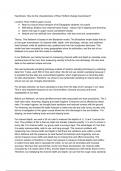Hypothesis: How do the characteristics of River Holford change downstream?
Location: River Holford upper course
● Near our school (easy transport of all Geography students via coach)
● Well-being: Shallow river channel below knees - reduce risk of slipping and drowning
● Same rock type in upper course (consistent results)
● Natural and non-artificial river characteristics, with less mud and contamination
Theory: This fieldwork is based on the Bradshaw model. The Bradshaw model states that as
a river goes downstream, its channel width, depth, river discharge, velocity, and sediment
load increase, while its sediment size, gradient and river bed roughness decrease. This
model has been accepted by many geographers since its publication, and the aim of our
fieldwork is to prove that this model is creditable.
In our fieldwork, we mainly focused on measuring channel width and depth to calculate cross
sectional area of the river, then measuring velocity to find the river discharge. We also took
data on the sediment shape and size.
We used systematic sampling technique instead of random sampling technique by collecting
data from 7 sites, each 500 m from each other. We did not use random sampling because it
is possible that the sites are concentrated together, which might prevent us recording data
for sites downstream. Therefore, we chose to use systematic sampling to reduce bias and
ensure we can see changes downstream.
For all data collected, we have calculated a mean from the data of all 4 groups in our class.
This is very important because we can rid anomalies, increase accuracy and prove
repeatability of our data.
Before our fieldwork, we have identified several risks associated and took precautions. The 3
main risks were: drowning, slipping and water hygiene. Everyone can be affected by these
risks. For water hygiene, we brought hand sanitizers and reduced contact with the ground.
For drowning, we checked the water forecast to make sure the day was sunny, we also only
did our investigation in the upper course where the river discharge is low and shallow . For
slipping, we wore trekking boots and anti-slipping boots.
For channel depth, we used a 30 cm ruler to measure the depths of ¼, ½ and ¼ across the
river. The problem of this is that we might not actually measure exactly ¼ ½ and ¾ across in
every site. For channel width, my group used a surveyor tape. The advantages of it are that
it is easily manoeuvrable, safe to use, and long enough. The common problem with
measuring river channel width and depth is that there are variations even within a small
50cm distance with the presence (or lack thereof) of bedrocks and irregularity, and we
cannot measure every width and depth due to it being time and effort consuming. The
common solution is therefore, to have more groups to measure channel depths and widths,
to collect more data sets to calculate the mean, so we can rid anomalies and increase
accuracy. We have then proved that, as the river flows downstream, the channel width
increased by 3.9 metres (from 0.6m), and the depth increased by 0.09 metres (from 0.01m).
Therefore, by multiplying the channel width and depth, we can find the rough cross sectional




